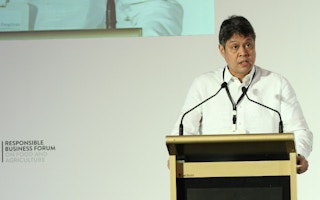While the Philippines achieved the second-highest GDP growth in the region last year after China, most Filipinos still do not have enough food for themselves or their families, said Secretary Francis Pangilinan, Presidential Adviser for Food Security and Agricultural Modernization on Monday.
To continue reading, subscribe to Eco‑Business.
There's something for everyone. We offer a range of subscription plans.
- Access our stories and receive our Insights Weekly newsletter with the free EB Member plan.
- Unlock unlimited access to our content and archive with EB Circle.
- Publish your content with EB Premium.
Opening the two-day Responsible Business Forum on Food and Agriculture in Manila, the former Philippine senator and vegetable-farming enthusiast made a case for sustainable agriculture before a crowd of over 150 international and local delegates from the government, civil society, and business community.
The sector, he noted, is fraught with critical challenges, such as climate change, food insecurity, and a rapidly increasing population. To ensure the sustainability of food and agriculture, farmers and agricultural communities must be put first and the sector must learn to produce more with less, he stressed.
“When agriculture and fisheries are seen as integral to our development, and not just as an outdated, ‘side project’, if I may put it that way, then we will see how government and all of its different branches, plus the private sector, can work together to modernize agriculture and fisheries and bring us to a new age of food security and sustainable agriculture,” he said.
Currently, the Philippines is already at 117 per cent beyond its sustainable limits, while Asia Pacific is at 77 per cent, said Lory Tan, vice-chairman and president of WWF-Philippines. This threshold, according to the Global Footprint Network that measures this ecological accounting, compares the the amount of resources people consume and the waste they generate to how fast the planet can regenerate what is used in a year.
Emphasised Tan in his welcome address: “Humanity is already consuming more than it can afford”. “The question has never been whether or not to develop, but how to develop and at what cost?”, he added.
Additionally, he asked the participants gathered at the Dusit Thani Manila: “Is there a way to cobble together a mosaic of locally appropriate formulas that fuel sustainable production, strengthen shared value chains, while involving the consumer?”
Jason Clay, senior vice-president for markets and food of WWF-US, who separately spoke at the opening, indirectly said yes. People involved in the production and consumption of food could assess the choices they make, he explained, citing how the production of beef, for example, takes up 60 per cent of all land used to produce food in the world yet only contributes 1.3 per cent of the world’s calorie intake.
“
When agriculture and fisheries are seen as integral to our development, and not just as an outdated, ‘side project’, if I may put it that way, then we will see how government and all of its different branches, plus the private sector, can work together to modernize agriculture and fisheries and bring us to a new age of food security and sustainable agriculture
Philippine Secretary Francis Pangilinan, Presidential Adviser for Food Security and Agricultural Modernization
A more efficient production – which is essentially climate-smart agriculture or agriculture that uses best practices to increase productivity and resilience while reducing emissions – and better consumption are needed, he said. To tackle the issue of agricultural productivity and food security, the world should find ways to meet its required calories and nutrients with less natural resources, he added.
Bindu Lohani, Asian Development Bank vice-president for knowledge management and sustainable development Bindu Lohani, who gave a keynote address, echoed the sentiment: “We should not only look at food, but nutritious food.”
“To effectively address food security, I think we need to drastically reform the entire food supply system, from farm to fork, or farm to chopstick,” said Lohani. Innovation through farming technologies and increasing research and development (R&D) are key factors to a successful transformation, he added.
If efficient production is crucial for food and agriculture in the short term, in ten to 20 years time, farmers and producers will need to switch crops, Clay pointed out. This pertains to crops that can replace those that will be affected by climate change, such as coffee in Mexico, he cited. The Central American country is already looking into varieties of cocoa to replace coffee, which may no longer grow adequately due to heat, he added.
Aside from selecting alternative crops, innovaton will also come in the form of better genetics or hybrids and other inputs like fertilisers, said the different experts.
However, Raul Montemayor, national business manager and program officer for the Federation of Free Farmers Cooperatives in the Philippines, noted the needs of the sector differently. During the plenary discussion on self sufficiency in Asia, he said, “Let’s not rack our minds for a solution.” More than technologies, basic services such as infrastructure like roads to markets and increasing farmers’ income or giving them the right renumeration for their produce are what farmers aspire for today, he explained.
“If we need to address food security, we need to take care of farmer,” Montemayor commented.
Similarly, Sec. Pangilinan closed his speech by sharing what his then nine-year-old daughter thought of farmers: farmers are like our parents, they feed us. More than doctors and lawyers, we need farmers and fishers since they feed us three times a day, he added.








